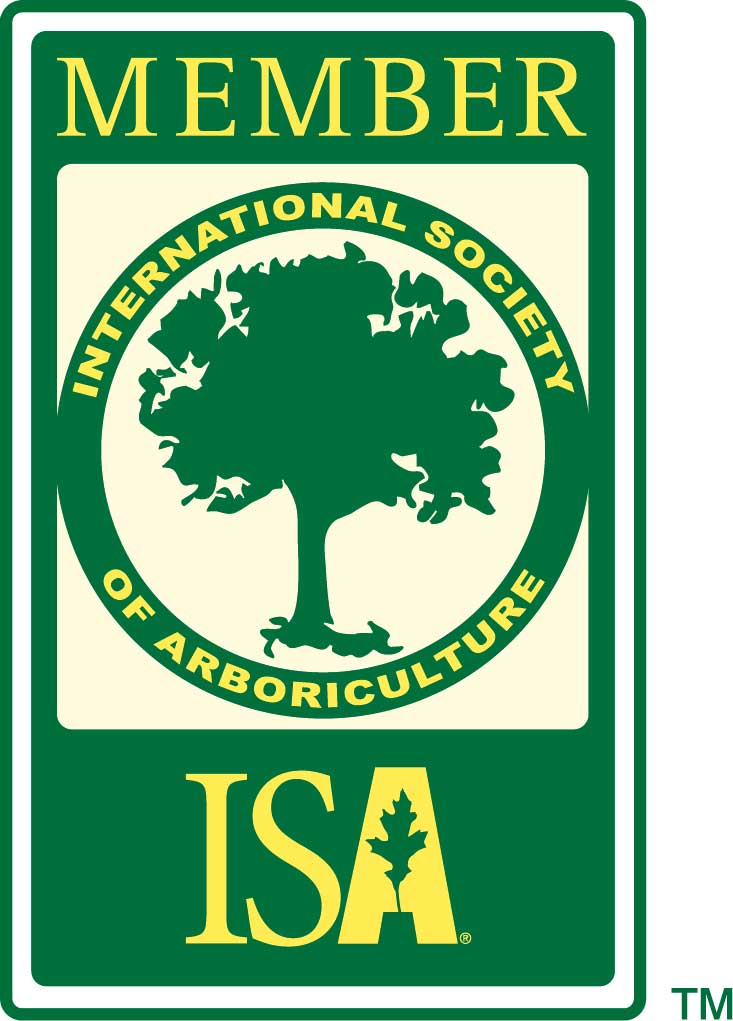Trees, Pesticides, and Pollinators
Lucas Capachin - Board Certified Master Arborist
Is the cure worth the cost?
I won’t go into any fun facts or stats on pollinators. You can read about their total value towards the agricultural industry or other things like that elsewhere. What I’m going to focus on here is pesticide use on trees and the impact that has on pollinators. I’ll help you become a more informed about pesticides and their potential to cause serious ecological damage.
Tree care pesticides
Three of the most commonly used pesticides that are toxic to bees are carbaryl, imidicloprid, and permethrin. These are only the most commonly used pesticides that are toxic to bees, there are many others that are toxic to bees although these are the ones used most around here. Pesticides can be sprayed on trees or applied to the soil as systemic pesticides.
These applications can harm bees in many ways. For example, systemic pesticides can be taken up by flowering plants and the pollen and nectar then become toxic. When taken back to the colony, the poisonous pollen and nectar can cause serious issues, including collapse of the entire colony. Other pesticides are known as contact pesticides, because they will kill bees on contact. This is actually the best outcome when it comes to poisoning bees, because at least they don’t bring it back to their colony to poison the other worker bees, larvae, and queen. Even pesticides that are applied at the right time and persist for relatively short periods of time can cause issues. Bees will go to water sources that are contaminated by overspray and be poisoned. Even when they consume non-lethal doses bees can suffer other health effects - from decreased ability to navigate, impaired motor function, decreased memory and ability to learn. All of these can cause a bee to not return home and die.
These chemicals do not only negatively impact bees. Other beneficial organisms - including ladybugs, earthworms, predatory wasps, and many more, are negatively impacted by pesticides. Runoff or overspray from pesticides can also injure to fish and other aquatic life. Many of these chemicals are considered safe to people, and that is why they are used. The interactions of these chemicals and the environment is often not studied because the companies applying and producing these chemicals would rather not have the negative effects caused by their products known. As we now know, the company that produced Roundup stated that it was “as safe as table salt”, all the while knowing that they had evidence of its carcinogenic effects.
Pesticide application
One way to limit the negative impacts of pesticide use is to choose a safe method of application.
Spraying
Spraying pesticides is certainly the most damaging way to control for insects. Many pest control specialists will claim they take all necessary precautions to avoid overspray and impact to non-target plants. But the reality is that it is essentially impossible to avoid these things. Especially in compact Colorado backyards there are always flowering plants and non-target plants within the area that is sprayed. These sprays are typically done from multiple angles to ensure the entire tree is covered, which means that everything under and around the tree will we sprayed. The nature of spraying trees makes it nearly impossible to not impact pollinators with the pesticide.
Soil application
Soil application is far better than spraying, but it can still cause issues. The good thing is that it is much easier to avoid non-target plants when applying pesticide to the soil. The main issue with soil applied systemic pesticides is that they will leach through the soil. If they come into contact with the roots of a plant that attract pollinators it will impact bees and other insects. These soil-applied pesticides not only can injure pollinators, they can also harm soil organisms.
Trunk injection
This method is generally considered the least harmful to not target organisms. This method involves drilling into the tree and injecting the pesticide directly into the trunk. This means that no pesticide ends up anywhere but inside of the tree. Although this is the best option it is important to remember that even this can impact non target organisms because the leaves, flowers, and pollen of these trees will still contain the pesticide.
Deciding to use pesticides
When taking advice from anyone (including me) you can ask yourself two things.
Are their intentions pure, or do they interests in conflict with my best interests? With pesticide application there are three main considerations and each company and person will value them to differing degrees. It’s important to think about how much the tree care professional is considering you, the environment, and personal gain.
If their values and intentions align with yours, then ask - do they have all of the information and knowledge necessary to provide good sound advice? The truth is, every one is going off of incomplete information. Sometimes there aren’t studies regarding certain impacts of some chemicals. Sometimes there is such limited information that the studies can’t be completely trusted. Think about the early COVID days, information was incomplete and often assumptions and conclusions were found to be incorrect. Even when a person or organization’s intentions are pure, the advice and information you get from them may not take everything into consideration and could have serious negative externalities.
I share these concerns to encourage you to be skeptical about information people share, and why they are sharing it. For example, I hear about companies telling people they need to spray pesticides to control Cooley spruce adelgid. But these insects do little damage to the health of the tree, and the decreased growth could actually be a benefit to the long term health of the tree. Despite this fact many plant healthcare techs and sales guys will receive a bonus for the upsell and will push it on their customers. This behavior may not always be malevolent in its intentions, but the end result can be far worse than the problem they solve.
Sometimes the pursuit of personal gain can cause people to do questionable things. The purpose of this article is not to say that all chemicals and pesticides should be avoided, but rather to encourage you to do research, and weigh the pros and cons of choosing when and how to use pesticide treatments.
Feel free to contact me if you are unsure about the pesticides being used around your property and the potential negative consequences. When it comes to pesticides Im always happy to spend a few minutes talking about the possible consequences of their use or misuse.
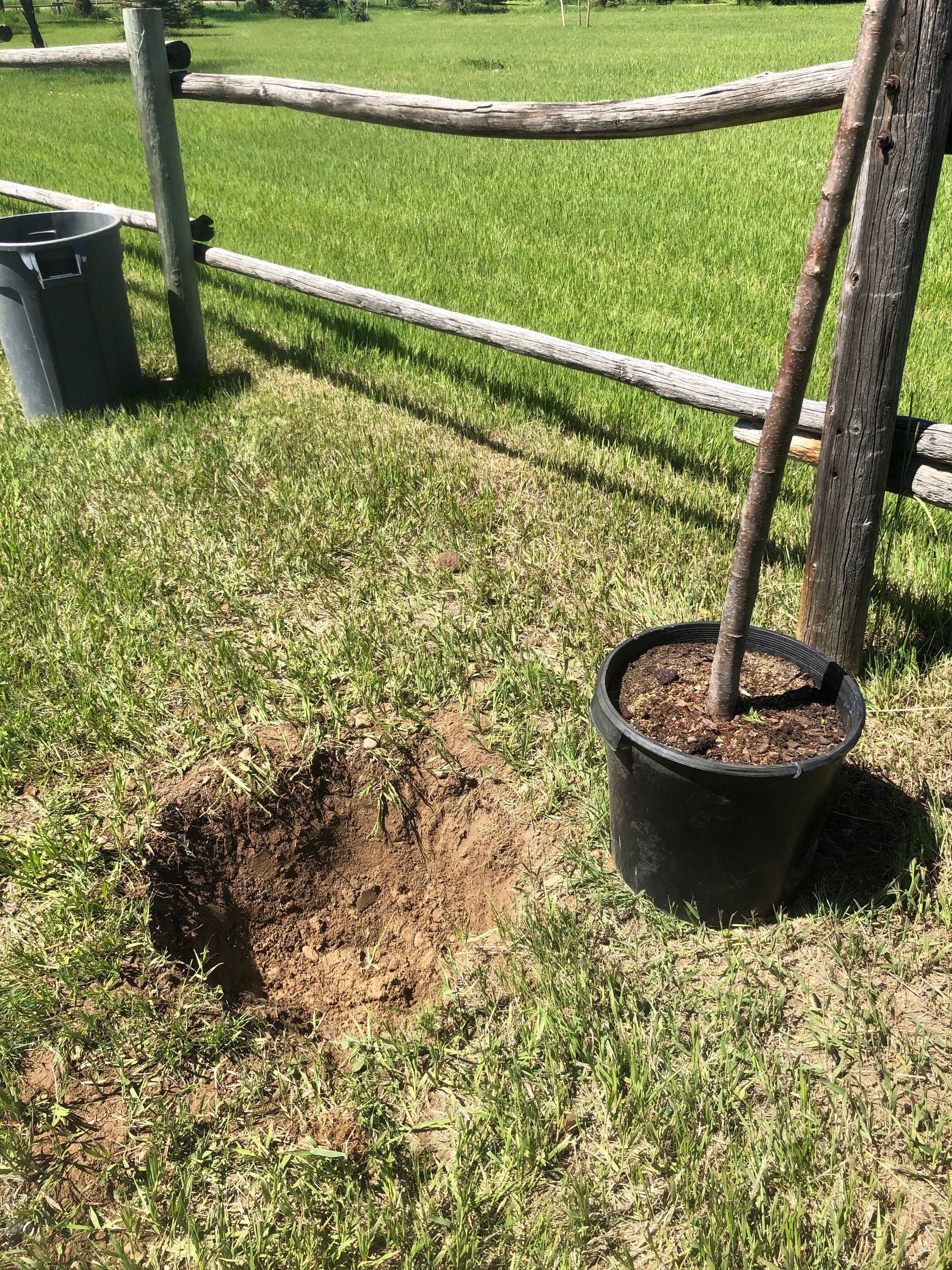
Watering newly planted trees The key is to make sure the tree gets enough water, but not too much. Typically you want to water a newly planted tree every 3-5 days, depending on how hot it is and how much rain there has been recently. The best way to know if you should water more or less is to just stick a finger into the dirt by the base of the tree before watering, if it feels very dry water more often, if its still very wet, water less often. Whoever sells the tree will have more advice on exactly how much each species needs and how often, but its very important to make sure its not getting overwatered or under watered. Every planting site is different, some have more runoff from gutter or other hard surfaces like concrete patios, others have better drainage. You just need to monitor the soil and get a feel for the specific tree's water needs in that spot. Large trees Autumn blaze maple - Maples can be prone to chlorosis but it can be managed. Its pretty much the only tree on the list that grows fast at all. Catalpa - I have almost never cut out a broken branch from one and don’t know if I've ever seen a dead one. Some people object to the giant seed pods. Kentucky coffeetree - very rarely break in storms. Burr oak - very rarely break in storms. Honeylocust - very rarely break in storms, thyronectria canker can be an issue on larger trees but generally isn’t an issue for the first 30-40 years Hackberry - Good tree, only issue is they are covered in hackberry nipple gall (funny name, I know). It doesn’t impact the health of tree at all, it's just an aesthetic issue. Small Smoke bush - Royal purple variety looks great and is a nice contrast in green yards. Flowers look cool. Redbud - Beautiful pink flowers in the spring. Prefers shaded areas, no direct sun all day. Good to plant with a larger tree that will give it shade for 1/2-1/3 of the day, relatively fast growing for being a small tree. Japanese tree lilac - Yellow flowers in the spring, I've never seen a dead one so they clearly do well in Colorado. Service berry - Native shrub to Colorado with nice spring flowers. Small berries attract birds in fall, awesome fall color. Amur maple - Grows fast (almost too fast sometimes) Awesome fall color. Peach - Don’t plant if you don’t like peaches! (If you don’t like them your neighbors probably do though). Grows very fast, in years where they produce fruit it can be excessive amount and can even cause damage to the tree. The weight of fruit will break branches as they ripen so be aware in the fall. Grows very fast for a small tree. For those looking for a really thorough discussion on trees from CSU extension, this link is a list of literally every tree in Colorado. It's got far more information than almost anyone needs but it does rank trees as recommended or not. https://planttalk.colostate.edu/wp-content/uploads/2024/04/2024-Front-Range-Tree-List.pdf
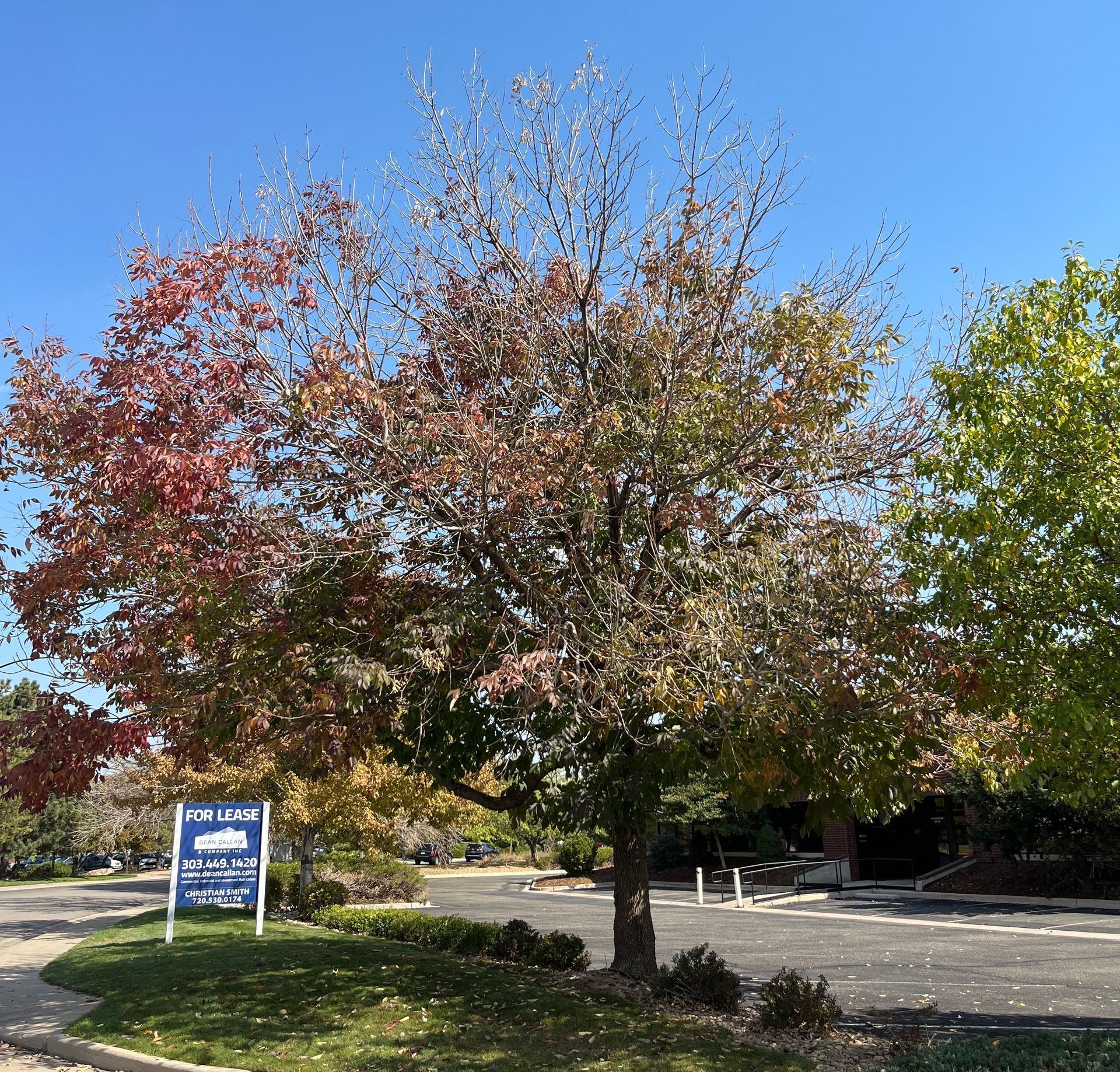
This linden isn’t getting enough water. Lindens typically need much more water than trees of other species in the same area. You can often identify the issue earlier in the year when you see browning along the edges of the leaf during the warmer months. Watering during the winter isn't always needed but it can give a tree like this the best chance to recover. Watering Article Winter Watering Article
I recently took a call from a fellow tree company owner. He was asking if I offer tree fertilization and offered me a commission on any sales I referred to his company. I told him I do not and then asked what the benefits of fertilizing trees were. I was curious if he knew what he was selling. The answer confirmed my suspicions that he doesn't actually understand the effects of fertilizing trees in Colorado. I decided to take 30-45 minutes out of my day to explain why fertilization is bad for trees in Colorado 99% of the time, and I also gave him alternative strategies that actually can help trees. I've often heard about fertilization from other companies as a great way to get more money per tree and a source of recurring revenue. Just upsell the customer on fertilization because “its good for the tree." I then decided to do some research, which confirmed my belief that in Colorado fertilizing trees generally leads to more adverse than positive effects. In this article I’ll go through the primary impacts that fertilization has on trees and why most of them are not beneficial for trees in Colorado.
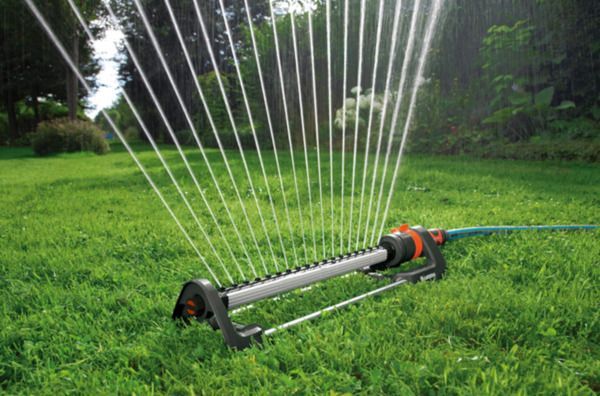
Do My Trees Need Water? A tree's roots will generally spread at least 2-3 times the width of the canopy of the tree. In Colorado landscapes that means that much of the roots exist in areas that do not get enough water. Watering should be focused within the drip line of the tree. The drip line is the entire circumference of the canopy of the tree where water would drip from the leaves and branches. Even if there is a garden bed that has some irrigation for plants planted in that area it is usually not enough for the trees, these systems are designed to give just enough water for the plants there and they rarely supply enough water for the tree. Any area within the drip line of the tree that has soil underneath should get supplemental watering including rock beds and even your deck. Yes, your neighbors may look at you strange when you are watering your deck but that is a small price to pay for healthy trees.
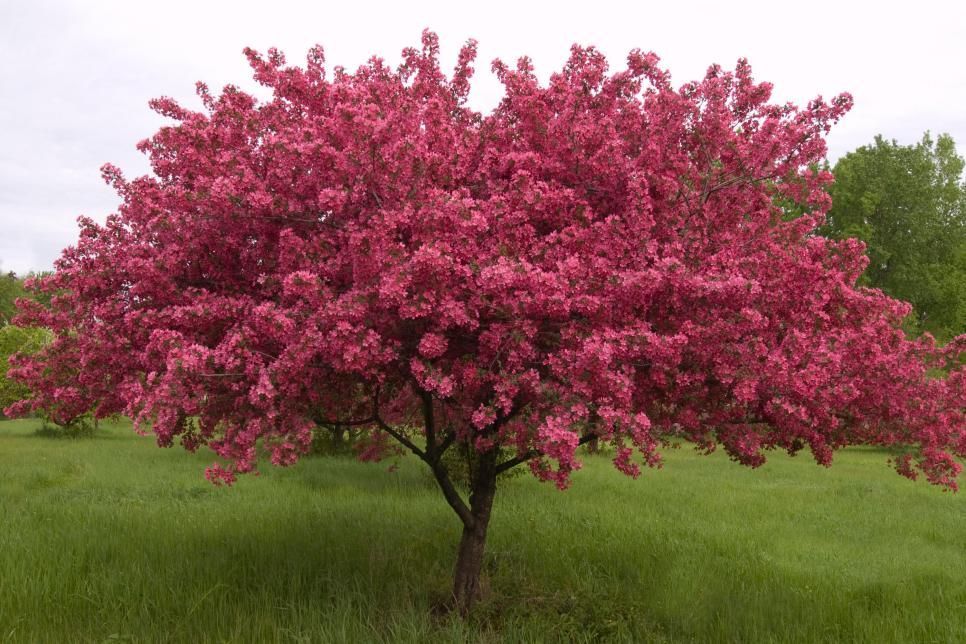
The key is to prune the trees before the snows come as this will mitigate the damage from heavy snow. Although pruning cannot guarantee that there won’t be any broken branches - it certainly does help. The issue is apples can only be pruned while there are no leaves on them because ((fireblight link)) can spread if they are pruned at the wrong time of year. Don’t forget to learn to identify fireblight and manage it early to prevent serious issues, our article has many photos and information to help. So feel free to contact us about your apples if you want to have them pruned before they start to leaf out. If you don’t want to prune them don’t forget to knock the snow off if we get a storm. If you want to try your hand at pruning youself this video gives a bunch of good advice!
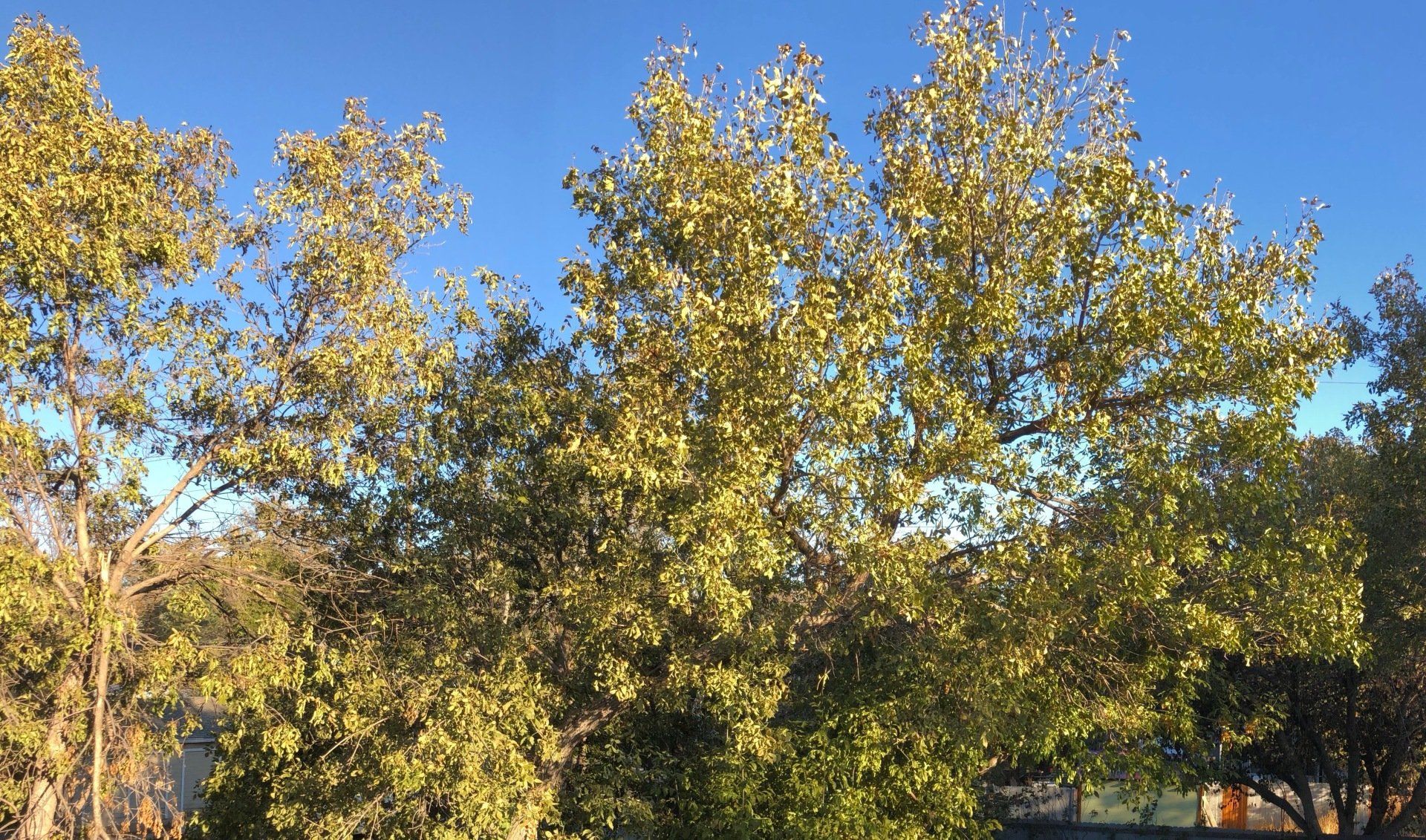
Frost Damage Trees prepare for the cold winter months in many ways to prevent damage to their cells. If trees start to reverse this process too early, a hard freeze can cause ice crystals to form in their cells. This can cause branch tips to die, or sometimes even entire branches or trees will die from frost damage. More information on frost damage can be found in a previous article I wrote found here . Trees that typically suffer the most from these cold snaps are stone fruit trees (all trees in the genus Prunus) and elms. A few years ago many pears were also severely affected. Unfortunately there isn’t much that can be done to prevent frost damage, although shaking snow off of trees and preventing the branches from dropping in temperature too much can help.
I often hear “winter is the best time to prune trees”. This, like many over generalizations is not always correct. When to prune is often dependent upon the goal you wish to achieve for your trees. We are actually fortunate in Colorado - most trees can be pruned any time of the year. With winter pruning we can see the structure of the tree without it’s leaves. For trees that are weak, pruning in winter helps them retain vigor through the growing season. Preventing storm damage In Colorado one of the major causes of tree issues is from our severe storms. We can have both high winds and heavy, unseasonable snow here. A more structurally sound, recently pruned tree canopy will eliminate weak limbs and decrease the surface area for the snow and wind to act upon. Thereby reducing the forces imparted on the tree and limiting the chance of storm damage. Disease prevention There is one group of trees that is best pruned in winter - species which are susceptible to fire blight. In Colorado there are four main trees that are susceptible, they are mountain ash (Sorbus), apples/crabapples (Malus), hawthorn (Crataegus), and pear (Pyrus). Creating new wounds from pruning during the growing season will increase the chances of it contracting fire blight, so that’s why we try to prune these trees in winter. Here is a link to our article on fire blight. FoothillsArborists.com/Fire-blight Resource allocation In spring trees use a large amount of water and nutrients to create new leaves. Trees grow fastest in early spring, this can be seen by looking at growth rings, the larger lighter colored rings are formed in early spring, the darker skinny sections in the later months of the growing season. Spring is also when new shoots appear and growth occurs. If pruning is done before this flush of growth it means that the tree will push out more new growth on the remaining branches. It will fill out quicker than if it were pruned after the flush of new spring growth. If done later in the season there will be less growth in response to the old cuts. This will decrease the new growth on the tree. Therefore one drawback of winter pruning is that pruning may need to be done again sooner as new spring growth will occur more quickly than with later pruning. If a tree is severely stressed it may be advisable to only prune in late winter to minimize stress and retain it’s resources for new growth in the spring on the remaining branches. Wound compartmentalization Wounds can come from pruning, nature’s forces breaking branches, or pests and disease. Trees do not heal wounds like we do when a cut in our skin is healed with new tissue growth replacing the damaged tissue. They can only seal off the exposed inner wood to prevent damage to nearby healthy tissue. The tree forms barriers to prevent wood-decay fungus from progressing into the heartwood of the tree. If large cuts are needed, for instance to remove a large broken limb, pruning in the winter will give it a head start on closing that wound. Pruning before the growing season will give your tree a head start on covering up the wounds. Although this is one of the main reasons given for winter pruning, it usually will not make a significant difference if pruning is done right - as only small cuts should generally be made and these are much easier for the tree to seal off. When people ask me “When is the best time to prune my trees?” I usually respond by saying “Before they are damaged in a storm”. The extreme weather we get in Colorado is hard on trees, and very few of the trees we plant evolved in this climate. The trees we have brought to Colorado and nurture here are not prepared for the extreme wind or early/late snowstorms when they are leafed out. Our main goal with pruning is to prevent this sort of damage from occurring. In the best case, loss of major branches leaves a less attractive tree. In the worst case, it can lead to the decline and death of the entire tree. Fortunately most trees can be pruned any time of the year, and that is why I rarely recommend delaying pruning. You never know when the next tree damaging storm will hit. There is nothing worse than showing up to prune a tree and seeing that it has been recently damaged by a storm, so it is almost always better to prune as soon as possible.

Chlorosis is a general term for foliage that is not producing adequate chlorophyll. This leads to a yellow or pale appearance. The lack of chlorophyll means that the plant's most important process is being interrupted. If not corrected, chlorosis will lead to dieback of branches and eventually the entire tree. Chlorosis generally is caused by a lack of iron, but it may also be caused by a deficit in other micronutrients as well. Iron is present in most Colorado soils but due to low pH it cannot be absorbed by the trees. How Can I Identify Chlorosis in My Trees? Chlorosis is a major problem with maple and oak trees in Colorado, although many other species can also be affected. The signs of chlorosis are any leaves or branches in the tree with inconsistent color. Parts of the tree may appear lime green while other parts are a deeper green. In advanced stages leaves will turn yellow and almost white at times. If you look at a leaf and the veins are darker green but the rest of the leaf is lighter in color - that is chlorosis.







